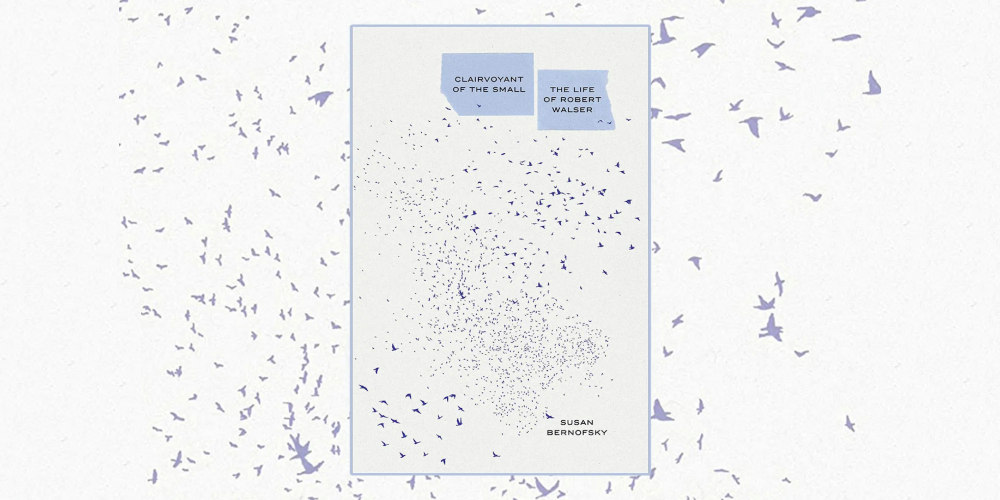Smallest Giant: Launching Susan Bernofsky’s New Walser Biography

It seems that to know Robert Walser is to love him. The great Swiss-German writer who lived, struggled, and worked prolifically in the early 20th century, a contemporary of Kafka and Herman Hesse, has been easily overlooked in the decades since his death, but for a robust and still growing following of Walser enthusiasts.
Among these admirers is Associate Professor Susan Bernofsky, who was joined last week by Professor Lis Harris, and other distinguished guests—all Walser devotees—to launch her new book, Clairvoyant of the Small: The Life of Robert Walser.
The Zoom event felt like a companionable love-in for the writer who has become a cult passion for so many.
Today, Walser is recognized as a high modernist ahead of his time, a revolutionary in his use of short prose forms, and a profound influence on writers like Walter Benjamin, Kafka, and Robert Musil.
He exercised his distinctive style in considering people on the fringes of society—as he himself often was. In Berlin’s restaurants, coffee houses, and cabarets, in the street or on the tram, he found the minute workings of power and difference; the enormous in the quotidian.
As poet Mark Wunderlich ’94 observed in his remarks, Walser was “drawn to the small encounters of dailiness.”
Indeed, Bernofsky’s title—Clairvoyant of the Small—is the moniker W.G. Sebald bestowed on Walser, in recognition of his attention to the outcasts of urban life.
Both Assistant Professor Rivka Galchen and Assistant Professor of Germanic Languages Annie Pfeifer, noted how deftly Bernofsky’s biography manages to be faithful to Walser’s own spirit.
Galchen remarked that the format of biography itself seems almost too grand, more pages than Walser himself would have liked, but Bernofsky fits the scale to the subject: “the kind of details she brings in, and the wryness and humour with which she brings them in, feel so fitting.”
It is a biography made up of “charismatic details,” she quipped.
Pfeifer commented on Bernofsky’s emphasis on plural ‘stories’ as key to her approach, employing “no overarching metanarratives” that one usually associates with the biography format. Instead, Bernofsky achieves “a Walserian approach to Walser,” Pfeifer said.
Walser himself was an often profoundly isolated outsider. He struggled to make a living, moving in and out of odd trades, and very frequently lived in poverty, refraining from turning on the heat in the winter to save money. Pfeifer notes that Bernofsky includes the full list of Walser’s known addresses in the book—there are sixty-five—an illustrative fact pointing to a precarious existence.
Galchen, and audience members in the Q&A portion, brought up the smallness of his handwriting, his preference for pencil, the fact that he often destroyed his letters and manuscripts, as evidence of a man who wrestled with his own recessiveness and ephemerality. The biography, Galchen commented, “respected and embodied that hesitancy, ambition, desire to be seen, fear of being seen.”
Walser struggled with his mental health throughout his life, and suffered a breakdown in his early fifties. He checked himself into a sanatorium, where he would spend the remainder of his life, dying of a heart attack on a lone snowy walk some twenty years later.
A question that Bernofsky introduced at the beginning of the evening recurred: Would Robert Walser have become the writer we love without the things he struggled through? Would the man so finely attuned to the emotional registers of the down-and-out, so agnostic of convention, have been so without his experiences of hardship and failure?
Does an artist have to struggle? “I don’t actually believe that’s true,” Bernofsky said, “but in his particular case, one wonders. His late work especially, which is the work that I care about the most deeply, is just one big virtuosic chronicle of failure. And he celebrates it beautifully.”
Strange yet fitting, commented Annie Pfeifer, that the writer who lived in near-obscurity should have a community of people who read him and love him—“the fans, if you will”—including his own contemporaries as well as modern names, like Jonathan Franzen and Ben Lerner.
In 2019, Pfeifer recalled, the artist Thomas Hirschhorn created an eighty-six day interactive Robert Walser celebration installation in Biel, Switzerland. Bernofsky and Pfeifer both attended. The installation was covered in DIY banners and signs, images you can now find online—notably one with a huge red heart proclaiming Walser love “FOR EVER.”
“Are all Walser fans in a sense Superfans?” Peifer asked.
Bernofsky agreed: “there’s something about his work that inspires this strange, irrational, passionate love...he still just blows my mind constantly, as a writer, and it’s his way of describing the world and relationships within it differently, strangely, wrongly.”
What better inducement to discover Walser for oneself than to spend an hour in the virtual company of such passionate, articulate Walser superfans—who are in turn Bernofsky fans as well.
“I am grateful to Susan Bernofsky,” Wunderlich reflected, “for her scholarship, her ample gifts as a translator, her thorough and humane work that has given us this insight into the life of the smallest giant of German literature.”